Computer-Aided Design 39 (2007) 276–283
www.elsevier.com/locate/cad
Detection of closed sharp edges in point clouds using normal estimation and
graph theory
Kris Demarsina,∗, Denis Vanderstraetenb, Tim Volodinea, Dirk Roosea
a Katholieke Universiteit Leuven, Department of Computer Science, Celestijnenlaan 200A, 3001 Heverlee, Belgium
b Metris N.V., Interleuvenlaan 86, B-3001 Leuven, Belgium
Received 18 May 2006; accepted 17 December 2006
Abstract
The reconstruction of a surface model from a point cloud is an important task in the reverse engineering of industrial parts. We aim at
constructing a curve network on the point cloud that will define the border of the various surface patches. In this paper, we present an algorithm to
extract closed sharp feature lines, which is necessary to create such a closed curve network. We use a first order segmentation to extract candidate
feature points and process them as a graph to recover the sharp feature lines. To this end, a minimum spanning tree is constructed and afterwards
a reconnection procedure closes the lines. The algorithm is fast and gives good results for real-world point sets from industrial applications.
c 2007 Elsevier Ltd. All rights reserved.
Keywords: Reverse engineering; Segmentation; Region growing; Sharp edges; Point clouds; Curve network
1. Introduction
Feature lines on a surface model can be mathematically
defined via local extrema of principal curvatures along
corresponding principal directions. These feature lines can
be used in a variety of applications, e.g. visualization,
improvement of the mesh quality, shape recognition, quality
control and reverse engineering.
Most feature line extraction algorithms rely on a triangular
mesh as input, e.g. [1–5]. Few algorithms only use a point
cloud, e.g. [6,7]. These existing methods usually result in pieces
of unconnected feature lines, making it hard to segment a point
cloud or mesh into surface patches, based on these lines.
A method to find the different surface patches with
corresponding boundaries is presented in [8]. This method
relies on a triangular mesh as input, but sometimes a mesh is
not given or it can be hard to generate one. A segmentation
algorithm that operates on point clouds is explained in [9]. This
method uses curvature information that is difficult to estimate
in a noisy environment.
In this paper, we aim at constructing a curve network on a
point cloud that will define the border of the various surface
∗ Corresponding author.
E-mail address: kris.demarsin@cs.kuleuven.be (K. Demarsin).
0010-4485/$ - see front matter c 2007 Elsevier Ltd. All rights reserved.
doi:10.1016/j.cad.2006.12.005
patches. Therefore, we focus on finding closed sharp feature
lines. Our method can be sketched as follows. First, a region
growing method is applied with normal estimation, which is a
modification of the method of Vanco et al. [10–12], to cluster
the points in order to reduce the point cloud size. We build and
manipulate a graph of these clusters, resulting in closed sharp
feature lines that fit the clusters such that the algorithm can be
used as a pre-process step to find the areas where a surface patch
can be defined. We are interested in point clouds from industrial
applications, where closed sharp feature lines can be detected.
It is not our goal to apply the algorithm to point clouds with free
form surfaces or fillets with a large radius.
The algorithm differs from existing feature line algorithms
by the fact that it reconstructs closed sharp feature lines. The
advantages of the algorithm are that (a) it is meshless, i.e. only
the coordinates of the points are used, (b) it
intelligently
clusters the points to create a graph that is much smaller than
the original cloud, thus making it practical for large point
clouds and, (c) it constitutes a pre-process step for surface
reconstruction.
An introduction to the algorithm, together with some results,
is published in [13]. In this paper, the algorithm is explained
in detail (see Section 2). In Section 3 we illustrate results
of the algorithm applied to realistic point clouds, i.e. point
�
K. Demarsin et al. / Computer-Aided Design 39 (2007) 276–283
277
Algorithm 1 High level description of the algorithm.
1. Segment point cloud using the normals ⇒ point clusters
(clusters) (Fig. 1)
2. Build graph Gall connecting neighboring clusters (Figs. 2
and 3(a))
3. Add edges, indicating a piece of a sharp feature line, to
Gall ⇒ Gextended (Fig. 3(b))
4. Build the pruned minimum spanning tree of Gextended ⇒
Gpruned mst (Fig. 3(c))
5. Prune short branches in Gpruned mst ⇒ Gpruned branches (Fig.
3(d))
6. Close the sharp feature lines in Gpruned branches ⇒ Gclosed
(Fig. 3(e))
7. Smooth the sharp feature lines in Gclosed ⇒ Gsmooth (Fig.
3(f))
Fig. 1. First order segmentation of two intersecting cylinders.
one side, which is undesirable in our algorithm. If a triangular
mesh is available, the 1-ring neighborhood of p can be used to
represent a good local neighborhood of p, with the neighbors
distributed around p. In the absence of a mesh, we approximate
this neighborhood by building a local mesh. We determine the
k nearest neighbors of p, with k large enough, by generating a
sphere with p as midpoint and a radius such that the k nearest
neighbors are inside this sphere. Then the least squares plane
through these points is constructed and the points are projected
on this plane. Next, we compute the Delaunay triangulation
of these projected points and only the points that share an
edge with p in this triangulation, constitute the Delaunay
neighborhood [14] of p, which is used as an approximation of
the 1-ring neighborhood.
The normal in p is estimated as the normal of the least
squares plane through the 1-ring neighborhood of p, as
explained in [15]. Since we only use a few points from the k
nearest neighbors (the 1-ring neighborhood), the value of k has
not much influence on the normal estimation when k is chosen
large enough. Consequently, setting the value of this parameter
to 20 was suitable for all the tested point clouds.
Region growing. We want to use a standard region growing
method to cluster the points based on the sharp edges using
only normal estimation. Hence, we use a modification of the
first order segmentation described by Vanco et al. [10–12]: only
one threshold angle αmax is used which specifies the maximum
acceptable angle between the normals of two adjacent points
in one cluster. At a sharp edge, the normal estimation depends
heavily on the computed 1-ring neighborhood, since this
neighborhood is very local and these neighbors are located on
both sides of the sharp edge. This means that the variation of the
normals along a sharp edge is high, resulting in large clusters
with low variation of the normals bounded by small clusters
with high normal variation. These small clusters indicate the
sharp edges. Fig. 1 illustrates the result of the first order
segmentation, applied to the point cloud of the two intersecting
cylinders, with each point colored corresponding to the cluster
it belongs to. Contrary to the method of Vanco et al. [10–12],
each cylindrical piece, bounded by sharp edges, consists of
only one large cluster with many small clusters defining the
boundary.
Fig. 2. The graph Gall; the area bounded by the rectangle is used to illustrate
the following steps of the algorithm in detail.
clouds obtained from scanning industrial parts. We formulate
the conclusions in Section 4.
2. Sharp feature line extraction algorithm
2.1. Algorithm overview
Given a point cloud, we extract closed polygonal lines
indicating the sharp edges. Algorithm 1 gives the different steps
of the algorithm that will be explained in this section. Each step
of the algorithm is illustrated in Figs. 1–3 for a point cloud
representing two intersecting cylinders.
2.2. First order segmentation of point cloud
Normal estimation and neighborhood selection. The first step
of the algorithm divides a point cloud in different clusters
of points using a region growing method. For that purpose,
we need for every point the neighboring points as well as an
estimation for the normal vector. In order to accurately detect
the transition from a smooth area to a sharp edge, the normal
vector is estimated as locally as possible. As we will see later
on, to detect the sharp edges, the neighbors of a point p need to
be distributed around p.
With uniform sampling density, we could use a few nearest
neighbors to represent the neighborhood of p, but in most
realistic point clouds this results in a neighborhood located on
�
278
K. Demarsin et al. / Computer-Aided Design 39 (2007) 276–283
Fig. 3. Result of each step of the algorithm illustrated with the detail of Gall indicated by the rectangle in Fig. 2. (a) Gall: graph of the clusters; (b) Gextended:
Gall with extra edges; (c) Gpruned mst: graph after building the pruned minimum spanning tree of Gextended; (d) Gpruned branches: graph after pruning short branches
in Gpruned mst; (e) Gclosed: graph after closing the sharp feature lines in Gpruned branches; (f) Gsmooth: graph after smoothing Gclosed.
Perfectly aligned points. Since high normal variation is caused
by differences in the 1-ring neighborhood, we can wonder how
the segmentation behaves on point clouds where the points are
perfectly aligned. Even in such an unrealistic case, there are
many small clusters at the sharp edges.
2.3. Building graph Gall of all clusters
Gumhold et al. [6] and Pauly et al. [7] introduced a graph
approach to extract feature lines at the level of individual points.
Since we are interested in sharp edges and the segmentation
gives a strong indication of the location of these sharp edges, we
base the algorithm on a graph structure at the level of clusters,
which yields a reduction in complexity. Contrary to [6,7], our
prime focus is to detect closed sharp feature lines. A connected
graph Gall is constructed, where each vertex represents a cluster
and each edge connects two clusters that contain at least one
point with overlapping 1-ring neighborhood. Note that in this
paper, an edge is a connection between two vertices in a graph
and a sharp edge is a feature of the point cloud with very
high normal variation. For every vertex of the graph we keep
a representative point of the cluster, i.e. its center of mass, and
its size in terms of points. In Figs. 2 and 3(a) only the edges
between two small clusters are plotted. It can be observed that
it is these edges that give us a first idea of the location of the
sharp feature lines. From now on, we only process the graph
and the point cloud is not needed anymore.
Since we have to distinguish between small and large
clusters, we could use a user-defined threshold. However, in
practice, there are many small clusters and less large clusters
with the large clusters much larger than the small clusters and
thus taking the average of all sizes of clusters is a good heuristic
value to separate the small clusters from the larger ones.
Fig. 4. The graph Gall plotted on the segmentation of two perpendicular planes.
part of the border between two large clusters, i.e. these edges
are located on a sharp edge and have to be included in the graph.
Therefore, we add edges to Gall connecting two small clusters
that share two large neighboring clusters.
This is illustrated in Fig. 4: due to the segmentation a small
cluster s1 may exist that has only one small neighboring cluster,
namely s2, and vice versa, which results in two unwanted gaps.
We add the edge (s3, s1) to Gall since s3 and s1 have two
common large neighboring clusters, namely l1 and l2. Similarly,
we add the edge (s2, s4) resulting in a graph Gextended with
no unwanted gaps. We can now understand why it was useful
to keep the edges involving a large cluster in the graph Gall:
the large neighboring clusters are easily found. To avoid the
addition of too many edges, e.g. in Fig. 4 we do not want s1
to get connected with s5, we only add edges with a euclidean
distance between the two representative points which is less
than the maximum euclidean distance between two small
neighboring clusters in Gall. A detail of the graph Gextended of
the two intersecting cylinders is illustrated in Fig. 3(b). As with
Gall, only the edges involving two small clusters are drawn.
2.5. Building Gpruned mst, the pruned minimum spanning tree
of Gextended
2.4. Adding edges to the graph Gall yielding Gextended
As already mentioned, our goal is to extract closed sharp
feature lines, but the graph Gall has already many unwanted
‘gaps’ between small clusters. These gaps are caused by points
on a sharp edge with a normal aligned with the normal of a
neighboring large cluster. The edges that close these gaps are
The edges of Gextended involving two small clusters give us
an idea of the location of the sharp feature lines. There are many
cycles and therefore, we construct the minimum spanning tree
(MST) of Gextended to remove them. For this purpose, weights
of edges between small clusters are calculated as the distance
between the representative points of the clusters. Additionally,
we attach large weights (larger than the weights between small
�
K. Demarsin et al. / Computer-Aided Design 39 (2007) 276–283
279
clusters) to edges involving a large cluster. Building the MST
of Gextended with these weights results in a graph with a reduced
number of edges of which only a limited number of edges
involve a large cluster. We can now remove these latter edges
which results in Gpruned mst, as illustrated in Fig. 3(c).
2.6. Construction of Gpruned branches by pruning short branches
in Gpruned mst
Although constructing the pruned minimum spanning tree
gives an initial reconstruction of the feature lines, the graph
Gpruned mst contains many short branches, as can be seen in
Fig. 3(c). It is desirable to remove such branches since they do
not correspond to actual features.
We use Algorithm 2 to prune using a maximum branch
length dmax. This is a similar method as in [6]. If all the
branches starting in a point are shorter or longer than the
parameter dmax then nothing is pruned in this point. In most
realistic cases, the noisy branches are shorter than the other
ones and, consequently, a good value for dmax can be found
such that the noisy branches are pruned. For the tested point
clouds in this paper, no input of the user was needed to fine-
tune dmax. Setting the value of this parameter to 5 gave good
results for all the tested models. A detail of the resulting graph
Gpruned branches for the two intersecting cylinders can be seen in
Fig. 3(d).
Algorithm 2 Pruning algorithm.
dmax = 5
for all points p in the graph Gpruned mst with more than 2
incident edges do
if minimum 2 incident branches have depth ≥ dmax then
remove all incident branches with depth < dmax
end if
if (exactly 1 incident branch has depth ≥ dmax) and
(minimum 2 incident branches have depth < dmax) then
from the short branches, keep only the one with the
largest depth
end if
end for
2.7. Building Gclosed by closing the sharp feature lines in
Gpruned branches
At this point, we have a graph Gpruned branches with a reduced
number of endpoints, i.e. vertices in the graph with exactly one
incident edge. Since our aim is to reconstruct closed lines, we
introduce a ‘connect’ algorithm to link each endpoint with a
suited point in the graph as follows: for each endpoint pi we
compute the set N of the n nearest neighbors:
• Case 1: there exists at least one other endpoint in N:
The endpoint pi is connected to the closest endpoint qi
in N which has no path with pi that is too short, i.e. the
number of edges of each path is above a certain threshold d.
In this way, we avoid generating small cycles, e.g. in Fig. 5
there exists a path between p1 and q2 which is too short
Fig. 5. Illustration of the connect algorithm. The circles with pi as midpoint
for i ∈ {1, 2, 3, 4} indicate the spheres containing the n nearest neighbors of
pi .
and, consequently, we do not connect them. A good endpoint
to link p1 with is q1: they have only paths which are long
enough. If no suitable endpoint is found in N, we do not link
pi to anything, i.e. it stays an endpoint, like endpoint p2 in
Fig. 5.
Since we have to search all the paths between pi and qi
and because there can be many (long) paths, we optimize the
algorithm by performing a depth first search with a restricted
depth d, i.e. if at depth d there is still no path found between
pi and qi , there are two possibilities: there is a path which
is long enough (longer than d) or there is no path. In both
cases, it is unnecessary to go deeper in the search tree, since
no small cycles will be generated following the current path
and we continue searching the other paths.
• Case 2: there exists no other endpoint in N:
This case is similar to the previous case, but now we link
pi with a point in N which has more than one incident edge.
For example p4 is linked to q4, but p3 stays an endpoint,
since all points in N would generate a small cycle when
connected with p3.
If, after the connect algorithm, there still exist endpoints,
we prune all remaining branches, e.g. in Fig. 5 the four short
branches ending in respectively p2, q3, q2 and p3 will be
pruned. The connect algorithm can be seen as a last clean
up step: ‘noisy’ branches, which are restricted to a minimum
because of the previous steps of the algorithm, are pruned and
all sharp feature lines are closed.
The value of n must be chosen carefully to ensure that the
needed points to link with are in N and to avoid connections
with points that are located too far away. The value of d must
be chosen such that all the sharp feature lines are extracted and
all noisy branches are removed. The graph Gpruned branches gives
an indication of the length of the closed loops we want to
reconstruct, which can aid in a first estimate for d. By studying
the neighboring points of the endpoints, the user gets an initial
estimate for n. Both parameters can be adjusted by the user until
the desired result is obtained.
The two endpoints that still existed in Fig. 3(d) are now
connected, as illustrated in Fig. 3(e).
�
280
K. Demarsin et al. / Computer-Aided Design 39 (2007) 276–283
Table 1
Information about the segmentation for the different point clouds
#Points
Avg
#Small clusters
#Large clusters
11 034
15 206
26 846
41 432
110 053
Phone small
Cube
Cylinders
Brick
Phone large
The column Avg shows the average number of points of the small clusters for
each data set.
1610
851
1696
3133
5247
1.24
1.17
1.11
1.43
1.62
37
6
10
36
69
Fig. 6. Results for the two intersecting cylinders. (a) Gclosed; (b) Gsmooth.
2.8. Generating Gsmooth by smoothing Gclosed
The method we use to get a smooth graph Gsmooth, see
Fig. 3(f), is explained in [16].
3. Results
A detail of the two intersecting cylinders was used to
illustrate the different steps of the algorithm. The whole graphs
Gclosed and Gsmooth are shown in Fig. 6(a) and (b). The results
for a cube can be seen in Fig. 7: we see how the connect
algorithm results in perfectly closed sharp feature lines. Fig. 8
shows the results for a detail of a mobile phone, a typical
example of a point cloud used in industrial applications. This
point cloud has been generated by a Metris LC15 scanner.1
We note that the algorithm does not guarantee good results
when two sharp feature lines are located too close to each other
depending on neighborhood selection and point density: there
is an unwanted gap at the right caused by the pruning, and there
exist some edges connecting two sharp feature lines. One way
to partially solve the latter problem would be to generate an
ellipsoid in the direction of the sharp feature line instead of a
sphere to find the neighboring points to connect to in the close
step.
The results for a larger part of the mobile phone are
illustrated in Fig. 9. Contrary to the previous point clouds, this
point cloud does not represent a solid, i.e. it has a boundary
which we extract and include in the graph. By comparing the
final graph with the segmentation, we see how well the detected
lines fit the segmentation, but we also see that a few sharp
feature lines are not detected because they consist of cycles
which are too short. Additionally, where two lines are located
too close to each other, they are extracted as one line.
A final point cloud is illustrated in Fig. 10. Five cylinders
are pointing out from a plane, with the small one pointing in
the opposite direction to the four other cylinders. This plane
is bounded by sharp edges caused by four neighboring planes
orthogonal to this plane. At the other side, these neighboring
planes constitute the boundary of the point cloud. This cloud
1 www.metris.com.
has an average distance between a point and the corresponding
1-ring neighbors of 1/2 mm and the noise is estimated as
30 µm (single sigma of local least squares plane). The noisy
parts of the point cloud produce many noisy branches in
Gpruned branches, especially in the neighborhood of the four
cylinders (see Fig. 10(c)). These branches are removed in the
final graph Gsmooth, illustrating the importance of the connect
algorithm in the presence of noise. The small cylinder is entirely
reconstructed, since it is closed at the top. Only the bottom
circles of the other four cylinders are reconstructed, since these
cylinders are open on the other side, i.e. they constitute four
holes in the point cloud. Since the boundary is not extracted for
this cloud, connecting edges between the sharp edges and the
boundary are missing in the final graph, i.e. they are removed
from Gpruned branches by the connect algorithm.
This latter point cloud, the brick example, illustrates how the
algorithm is influenced by noise: small clusters are created at
the noisy parts. When we apply the algorithm to point clouds
with very high noise, the segmentation step results in small
clusters without any large ones. In such cases, a smoothing
method should be applied first and a larger neighborhood for
normal estimation can be used. In this paper, it is not our
intention to give a deep analysis of the algorithm in the presence
of high noise.
Table 1 presents information about
the segmentation.
Because of the high normal variation at the sharp edges, the
average size of a small cluster is close to unity. In the case
of the cube and the cylinders, we see that the segmentation
results in the correct number of large clusters: the large clusters
fit the extracted sharp feature lines perfectly. Table 2 gives for
every step of the algorithm the number of vertices and edges
of the corresponding graph. In the case of the two intersecting
cylinders, we start with a point cloud of 26 846 points and then
we build a graph Gall of 1706 vertices and 6086 edges. After
adding edges to Gall, every following step reduces the memory
consumption of the graph: a huge reduction in the number of
edges happens when building Gpruned mst and Gpruned branches. In
general, in the close step, more edges are removed than added,
since noisy branches are pruned. Note that for the large mobile
phone point cloud the boundary is included just before the close
step.
The table also illustrates the time consumption of the
algorithm. The segmentation step (−→n + RG) requires more
time compared to the other steps of the algorithm, because
this step has to grow through all the points of the point cloud
and the normal for each point needs to be estimated. We
�
K. Demarsin et al. / Computer-Aided Design 39 (2007) 276–283
281
Fig. 7. Result of each step of the algorithm applied to the cube. (a) Gall; (b) Gextended; (c) Gpruned mst; (d) Gpruned branches; (e) Gclosed; (f) Gsmooth.
Fig. 8. Result of each step of the algorithm applied to the mobile phone point cloud. (a) Gall; (b) Gextended; (c) Gpruned mst; (d) Gpruned branches; (e) Gclosed;
(f) Gsmooth.
Fig. 9. Results for a larger detail of the mobile phone. (a) and (b) illustrate two different views of the segmentation; (c) Gsmooth.
Fig. 10. Results for the brick point cloud. (a) Point cloud with flat shading; (b) segmentation; (c) Gpruned branches; (d) Gsmooth.
�
282
K. Demarsin et al. / Computer-Aided Design 39 (2007) 276–283
Table 2
Complexity and time consumption of the different steps
Gextended
8776
5251
8984
9716
27 538
1647
857
1706
3169
5316
Gpruned mst
1604
850
1690
2543
5199
1607
851
1696
2720
5215
Gpruned branches
1225
685
1123
1992
4040
1228
686
1129
2169
4056
Gclosed
1170
690
1076
1456
4579
1162
686
1076
1449
4527
Total
Edges
Phone small
Cube
Cylinders
Brick
Phone large
Vertices
Phone small
Cube
Cylinders
Brick
Phone large
Time (s)
Gall
5206
2835
6086
8210
16 198
1647
857
1706
3169
5316
RG
−→n
1.69
2.02
3.71
6.06
16.01
Phone small
2.55
Cube
2.52
Cylinders
4.81
Brick
9.27
Phone large
21.30
The segmentation is decomposed in two steps: The normal estimation (−→n ) and the region growing (RG). The timings are in seconds and generated on an Intel Pen-
tium 4, 3.20 GHz.
0.11
0.11
0.20
0.58
1.06
Gpruned branches
0.04
0.01
0.04
0.08
0.12
Gclosed
0.09
0.02
0.08
0.71
0.96
Gall
0.18
0.08
0.23
0.33
0.66
Gextended
0.39
0.25
0.49
1.43
2.32
Gpruned mst
0.05
0.03
0.06
0.08
0.17
could make the segmentation much faster by estimating the
normal as the normal of the least squares plane through the
k nearest neighbors instead of using the 1-ring neighborhood
(see Section 2.2). But for realistic point clouds, a small k
might generate neighbors only on one side of the sharp edge
causing no small clusters, and a large k makes it impossible to
accurately detect the transition from a smooth surface to a sharp
edge.
The following parameters are used by the algorithm: αmax
(angle in the segmentation), k (to estimate the normal), dmax
(needed in the pruning algorithm), and n and d (used in the
connect algorithm). Most of these parameters have the same
value for all tested models: αmax = 8◦, k = 20 and dmax = 5.
Only a few parameters need to be specified by the user, namely
n and d in the connect algorithm (see Section 2.7).
4. Conclusion and future work
We presented an algorithm to extract sharp edges from
a point cloud without estimating the curvature and without
triangulating the point cloud. Additionally, all extracted lines
are closed at the end of the algorithm. We start with a very
simple region growing method with well chosen normals,
resulting in an initial clustering based on the sharp edges.
Afterwards, we build and manipulate a graph of the clusters.
Using a graph structure at the level of clusters yields faster
execution times and less memory consumption, making the
algorithm suitable for large point clouds. Once we build the
graph of the clusters, the point cloud is no longer needed and
we only process the graph in the following steps: adding extra
edges, construction of the minimum spanning tree, pruning,
closing and smoothing the sharp feature lines.
The segmentation step and the creation of the closed lines
constitute a pre-process step in finding a curve network. In the
future, we plan to construct this network, which consists of a
set of loops, where each loop defines the boundary of an area
where a patch can be fitted. When all these segments are known,
we can continue with each segment individually to detect also
tangent continuous but curvature discontinuous features like
fillets.
Acknowledgement
The two mobile phone point clouds and the brick cloud are
courtesy of Metris N.V. Belgium.
References
[1] Hildebrandt K, Polthier K, Wardetzky M. Smooth feature lines on surface
meshes. In: Symposium on geometry processing. 2005. p. 85–90.
[2] Ohtake Y, Belyaev A. Automatic detection of geodesic ridges and ravines
on polygonal surfaces. The Journal of Three Dimensional Images 2001;
15(1):127–32.
[3] Ohtake Y, Belyaev A, Seidel HP. Ridge-valley lines on meshes via implicit
surface fitting. In: SIGGRAPH. 2004. p. 609–12.
[4] Stylianou G, Farin G. Crest lines extraction from 3D triangulated meshes.
In: Hierarchical and geometrical methods in scientific visualization. 2003.
p. 269–81.
[5] Watanabe K, Belyaev AG. Detection of salient curvature features on
polygonal surfaces. Computer Graphics Forum 2001;20(3):385–92.
[6] Gumhold S, Wang X, MacLeod R. Feature extraction from point clouds.
In: Proceedings of the 10th international meshing roundtable. 2001.
p. 293–305.
[7] Pauly M, Keiser R, Gross MH. Multi-scale feature extraction on point-
sampled surfaces. Computer Graphics Forum 2003;22(3):281–90.
[8] Meyer A, Marin P. Segmentation of 3D triangulated data points using
edges constructed with a C1 discontinuous surface fitting. Computer
Aided Design 2004;36:1327–36.
[9] Yang M, Lee E. Segmentation of measured point data using a parametric
quadric surface approximation. Computer Aided Design 1999;31:449–57.
�
K. Demarsin et al. / Computer-Aided Design 39 (2007) 276–283
283
[10] Vanco M, Brunnett G, Schreiber Th. A direct approach towards automatic
surface segmentation of unorganized 3d points. In: Proceedings spring
conference on computer graphics. 2000. p. 185–94.
[11] Vanco M, Brunnett G. Direct segmentation for reverse engineering. In:
Proceedings international symposium on cyber worlds. 2002. p. 24–37.
[12] Vanco M, Brunnett G. Direct segmentation of algebraic models for reverse
engineering. Computing 2004;72(1–2):207–20.
[13] Demarsin K, Vanderstraeten D, Volodine T, Roose D. Detection of closed
sharp feature lines in point clouds for reverse engineering applications. In:
Proceedings of geometric modeling and processing. 2006. p. 571–7.
[14] Floater MS, Reimers M. Meshless parameterization and surface
reconstruction. Computer Aided Geometric Design 2001;18(2):77–92.
[15] Hormann K. Theory and applications of parameterizing triangulations.
Ph.D. thesis. Department of computer science, University of Erlangen;
2001.
[16] Volodine T, Vanderstraeten D, Roose D. Smoothing of meshes and point
clouds using weighted geometry-aware bases. Report TW 451. Belgium:
Department of computer science, K.U. Leuven; 2006.
�

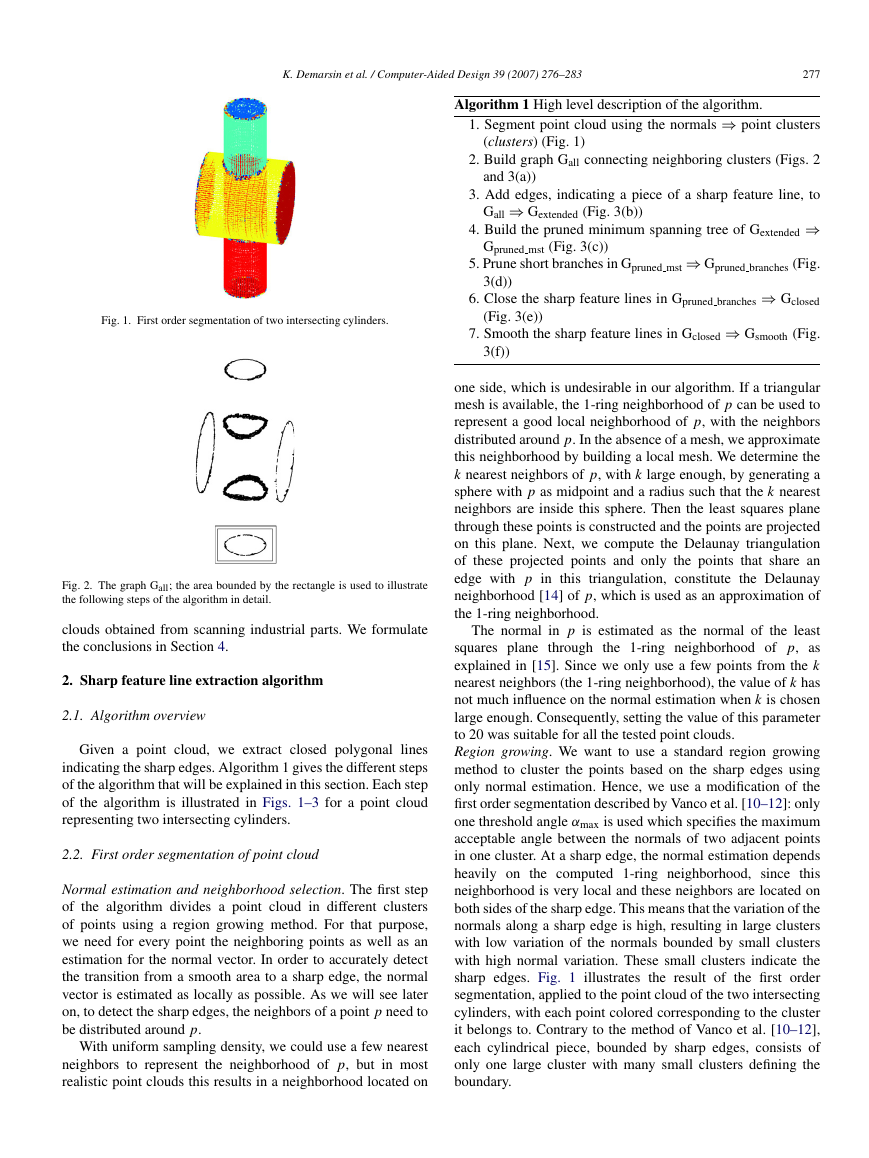
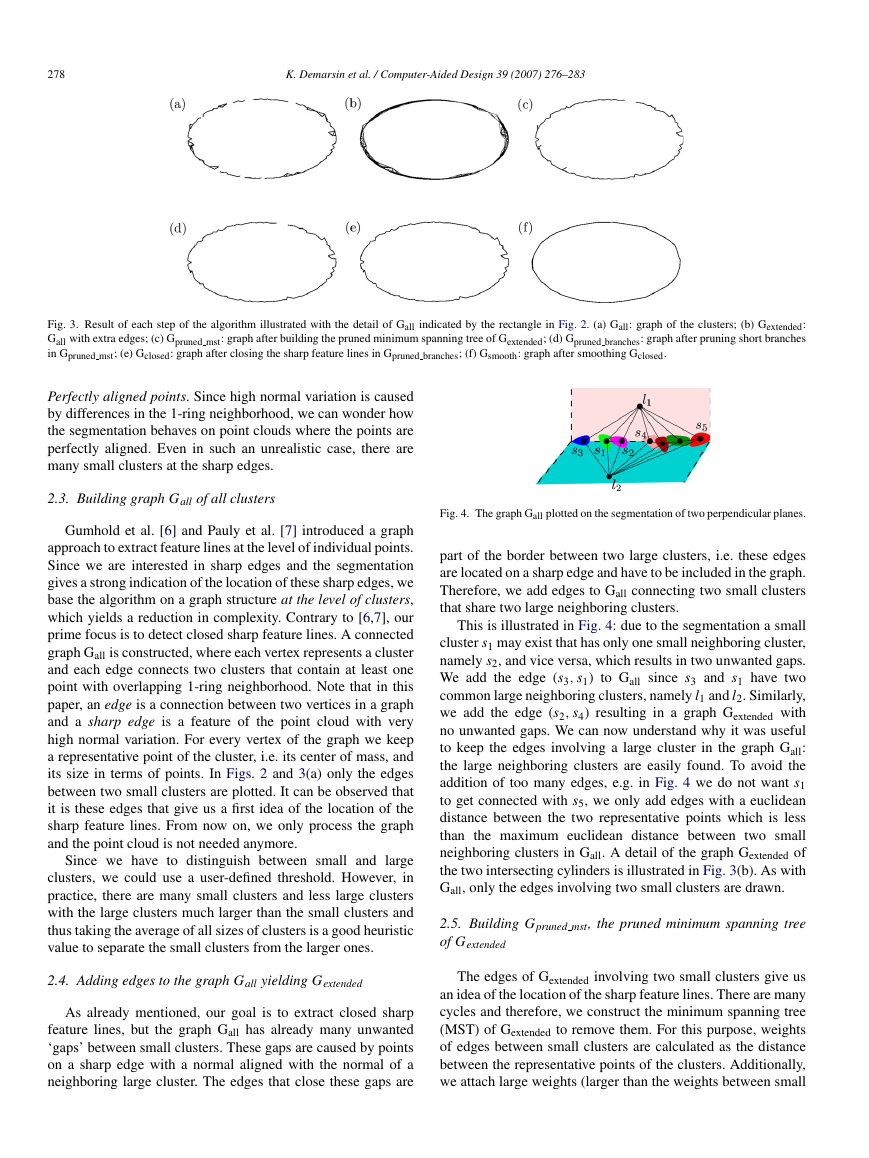

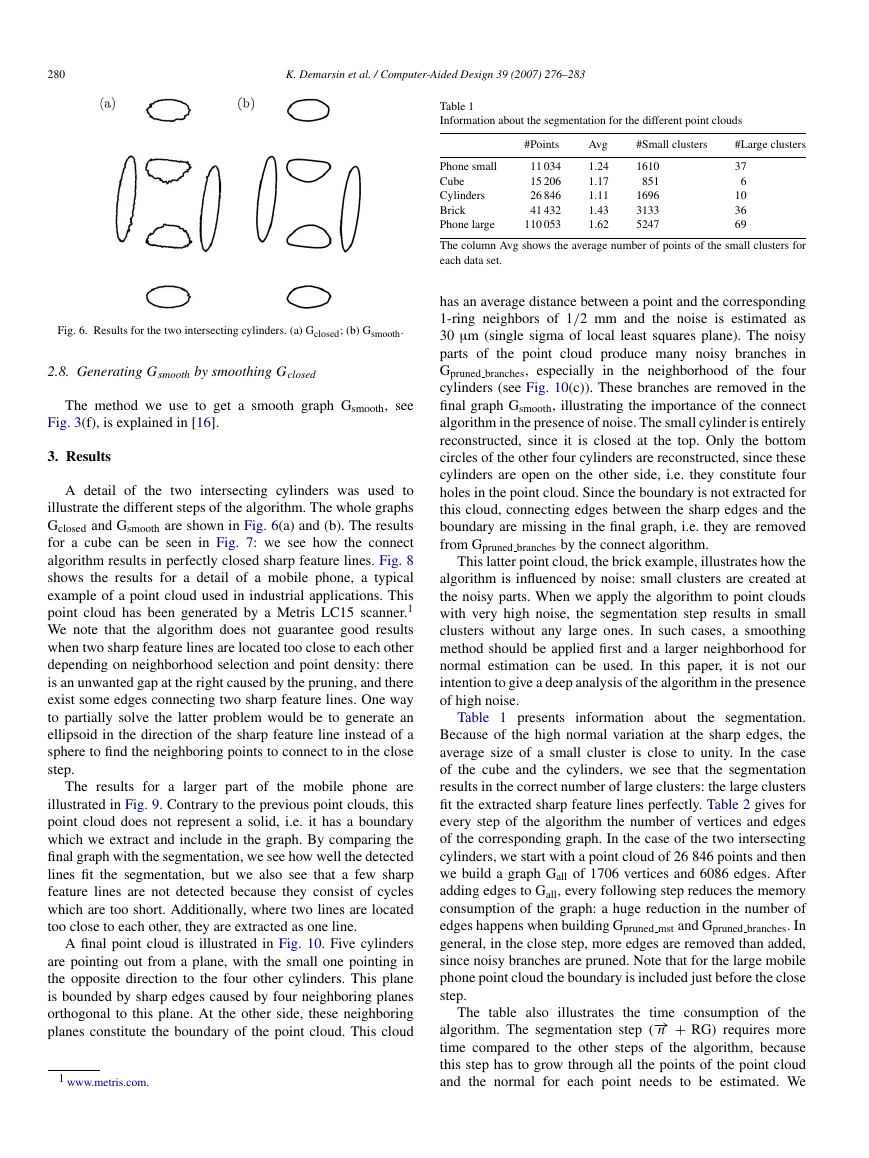
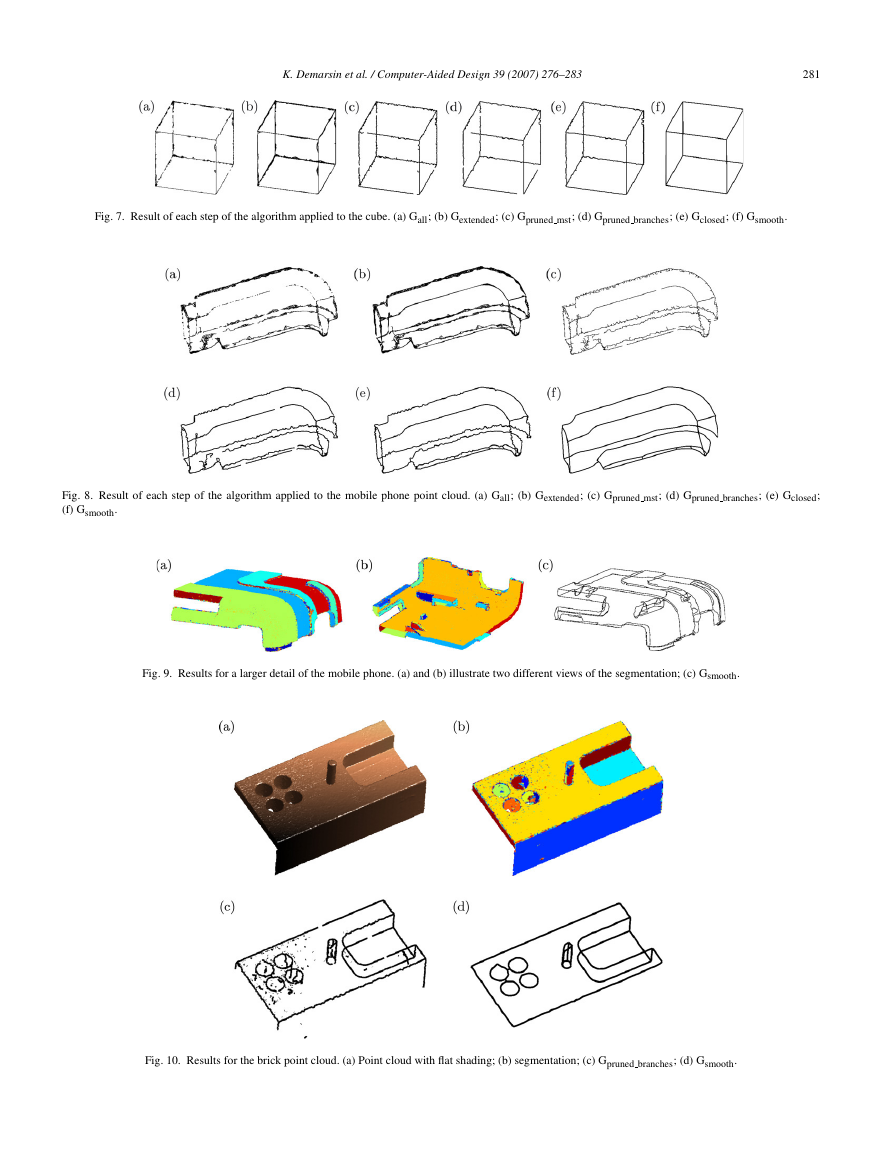
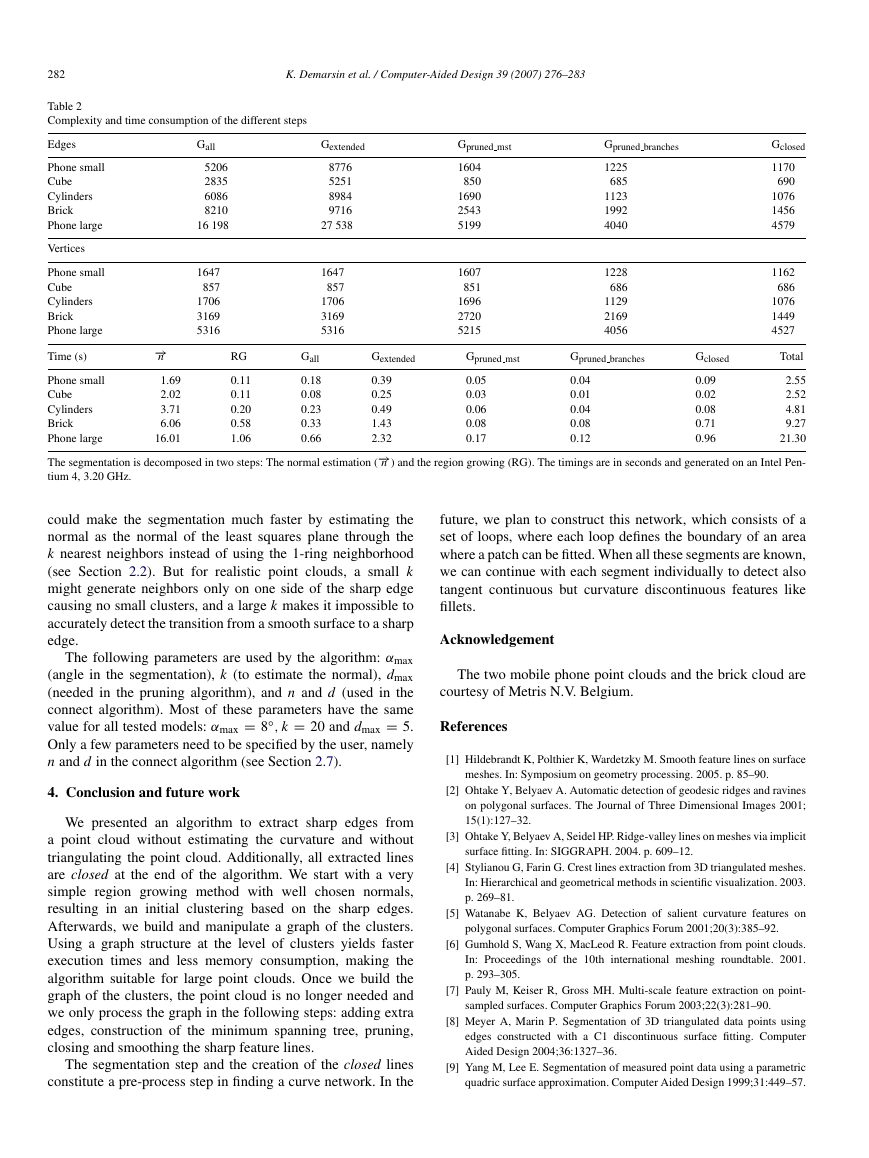









 2023年江西萍乡中考道德与法治真题及答案.doc
2023年江西萍乡中考道德与法治真题及答案.doc 2012年重庆南川中考生物真题及答案.doc
2012年重庆南川中考生物真题及答案.doc 2013年江西师范大学地理学综合及文艺理论基础考研真题.doc
2013年江西师范大学地理学综合及文艺理论基础考研真题.doc 2020年四川甘孜小升初语文真题及答案I卷.doc
2020年四川甘孜小升初语文真题及答案I卷.doc 2020年注册岩土工程师专业基础考试真题及答案.doc
2020年注册岩土工程师专业基础考试真题及答案.doc 2023-2024学年福建省厦门市九年级上学期数学月考试题及答案.doc
2023-2024学年福建省厦门市九年级上学期数学月考试题及答案.doc 2021-2022学年辽宁省沈阳市大东区九年级上学期语文期末试题及答案.doc
2021-2022学年辽宁省沈阳市大东区九年级上学期语文期末试题及答案.doc 2022-2023学年北京东城区初三第一学期物理期末试卷及答案.doc
2022-2023学年北京东城区初三第一学期物理期末试卷及答案.doc 2018上半年江西教师资格初中地理学科知识与教学能力真题及答案.doc
2018上半年江西教师资格初中地理学科知识与教学能力真题及答案.doc 2012年河北国家公务员申论考试真题及答案-省级.doc
2012年河北国家公务员申论考试真题及答案-省级.doc 2020-2021学年江苏省扬州市江都区邵樊片九年级上学期数学第一次质量检测试题及答案.doc
2020-2021学年江苏省扬州市江都区邵樊片九年级上学期数学第一次质量检测试题及答案.doc 2022下半年黑龙江教师资格证中学综合素质真题及答案.doc
2022下半年黑龙江教师资格证中学综合素质真题及答案.doc